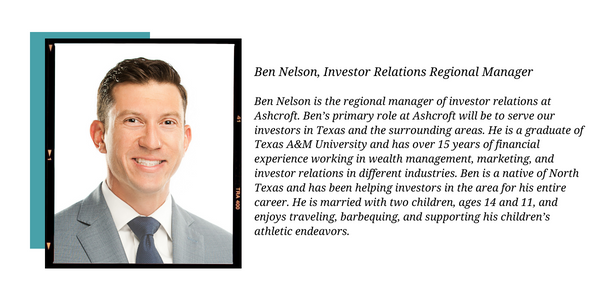September 28, 2023
By: Ben Nelson, Investor Relations Regional Manager
Famous industrialist Andrew Carnegie once said, “Ninety percent of all millionaires become so through owning real estate. More money has been made in real estate than in all industrial investments combined.”[1]
Although the exact figure will never be verified, it is safe to assume most people of wealth have had success with real estate along their financial path. Most people will own a home and watch that property appreciate over decades. For others, they will create wealth through buying and managing one or more rental properties.
In the 1930s, a real estate attorney named Larry Wien pioneered a way for investors to aggregate their capital to purchase larger properties in vehicles known as syndications.[2] The syndication structure allows investors to own a fraction of the interest in a property they would otherwise be unable to afford on their own and opens a new world of exciting investment opportunities.
But nothing is 100% guaranteed, and making any investment comes with risk. However, the amount of risk you take can be mitigated by doing research on who is managing your capital. When it comes to multifamily syndications, I speak with investors who have fallen on both ends of the spectrum. Some syndicators develop strong relationships, make calculated decisions, and earn trust over time. Some cut corners, mismanage assets, and fail to do what they say they are going to do. How does one distinguish one from another?
You can start by asking the right questions. Here are three key questions you should ask each and every multifamily syndicator before making investment decisions.
Does your team have experience navigating both up and down markets?
In a perfect world, your asset manager would always outperform the markets when conditions are favorable, and they would not lose money when conditions are unfavorable. They would essentially deliver high alpha, a rearview financial metric that measures excess returns, and low beta, which measures the correlation of risk relative to asset class or indices. Although it’s not impossible, achieving this is rare and typically short-lived. Most investors find they have to choose.
Do you want outperformance, protection, or something in between? Working with investors during the Great Recession of 2008–2009, finding investments and managers that could outperform during the rough times became more valuable, even if it meant sacrificing returns when times improved. How a firm could handle a storm proved far more valuable than how it did when the sun was shining.
Ashcroft Capital started buying multifamily properties in 2015, so one could assume we have operated only in low-stress markets where the economics favored real estate investments. That couldn’t be further from the truth. Ashcroft’s acquisition team has over 70 years of experience in navigating markets with low and high volatility. Rising interest rates and fear-inducing headlines are not causes for panic but opportunities to use our experience to our advantage.
Overall deal flow is down significantly in 2023, but our team has still managed to purchase over $260 million of multifamily properties with strong growth potential in highly desirable markets. In each of these transactions, sellers came directly to us for our ability to execute.
Do you have a well-defined strategy with a track record of success?
When investing with syndicators or asset managers over a long period of time, you will find there are good years and bad years. No one is perfect, and it’s common to experience pleasant surprises along with occasional disappointments. The key is long-term consistency.
It is human nature for a syndicator to become tempted to focus on a different sector or asset class they believe has more short-term growth potential, even if they lack the necessary experience in that area. This is known as style drift, and although it is sometimes necessary given a rapidly changing global economy, it must always be scrutinized carefully.
With Ashcroft Capital, you know what you are getting: intense acquisition due diligence, conservative return projections, well-executed property improvements, and a consistent track record of timely dispositions. We’re not experimenting with buying storage units or car washes. We buy multifamily properties with a minimum of 200 units in Sunbelt markets that show the potential to generate healthy upside for our partners. Our strategy has remained steady, and our investors have seen the benefit of this repeatable and well-defined strategy. Going full cycle on 26 assets and generating a net 25.6% annual cash-on-cash return for our investors is no accident.*
Who operates your properties, and how well?
Anyone who has ever hired a property manager knows how important that decision will be to maximize investment returns. A skilled property manager will maintain the property in a timely fashion, keep the owner well-informed, and encourage a sense of community that keeps tenants coming back time and time again.
However, all too often property managers are spread too thin and must focus on multiple properties at one time. This can lead to tenant dissatisfaction, low occupancy, high expenses, and a small bottom line. Many property managers will operate at a level to maintain their position and little else.
In Ashcroft’s earliest days, we used a third-party property manager on our deals and quickly decided to make sweeping changes. Rather than move from one manager to the next, we decided to create Birchstone Residential. Today, Birchstone employs over 300 people and manages all of Ashcroft’s properties exclusively.
By being vertically integrated, we have complete control over what happens on our properties and when. Aside from control, vertical integration offers many other benefits, such as increased transparency of daily operations, the ability to pivot quickly, lower expenses, and an established and repeatable road map to growth.
Ashcroft Value Add Funds
These are important questions to ask, but there are many others to consider, such as “What percentage of your investors invest with you multiple times? Will you share any referrals of existing investors?” For Ashcroft, the answers to those questions are, respectively, over 65%, and yes, we absolutely will. We are comfortable with our strategy and proud of our success, but we also love the relationships we’ve built with our limited partners.
So many of our investors decided to place their capital in each of our deals regardless of the market environment, and it is one of the biggest reasons we are excited about our Ashcroft Value Add Funds. If you’d like to learn more about our current offering and the terms of properties we purchased, reach out to us at investorrelations@ashcroftcapital.com to speak with one of our IR team members.
Sources:
- “Andrew Carnegie Quotes” AZ Quotes 2023, https://www.azquotes.com/quote/856550.
- “About ESRT” Empire State Realty Trust 2023, https://investors.esrtreit.com/about-esrt/about-esrt/default.aspx.
*Past performance is no guarantee of future results and should not be relied upon as an indicator of the Partnership’s future performance or success. An investment in the Partnership is highly speculative and entails a high degree of risk, including the risk of loss of a Limited Partner’s entire investment. There can be no assurance that the Partnership will achieve its investment objectives or that the Limited Partners will receive a return of their capital.



